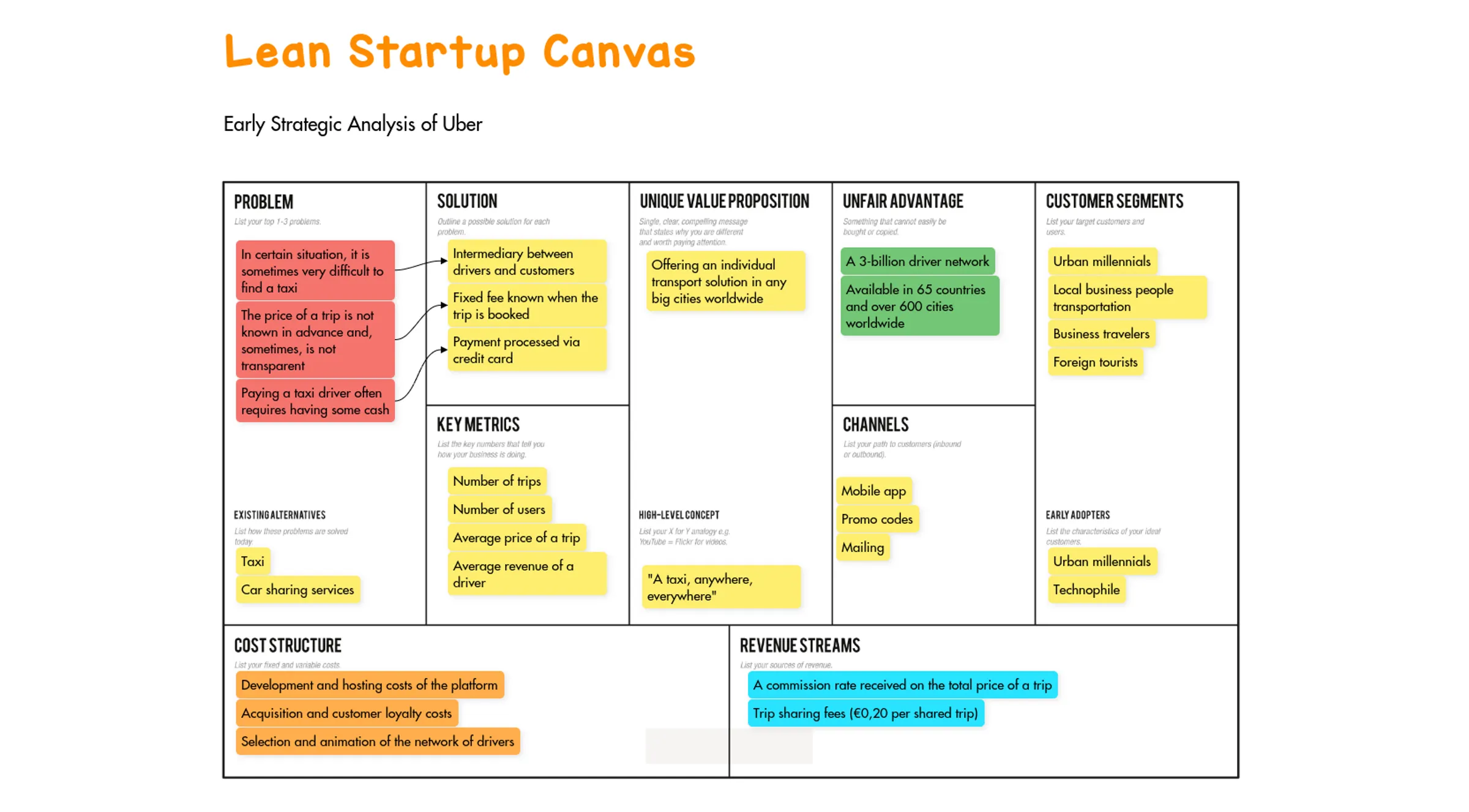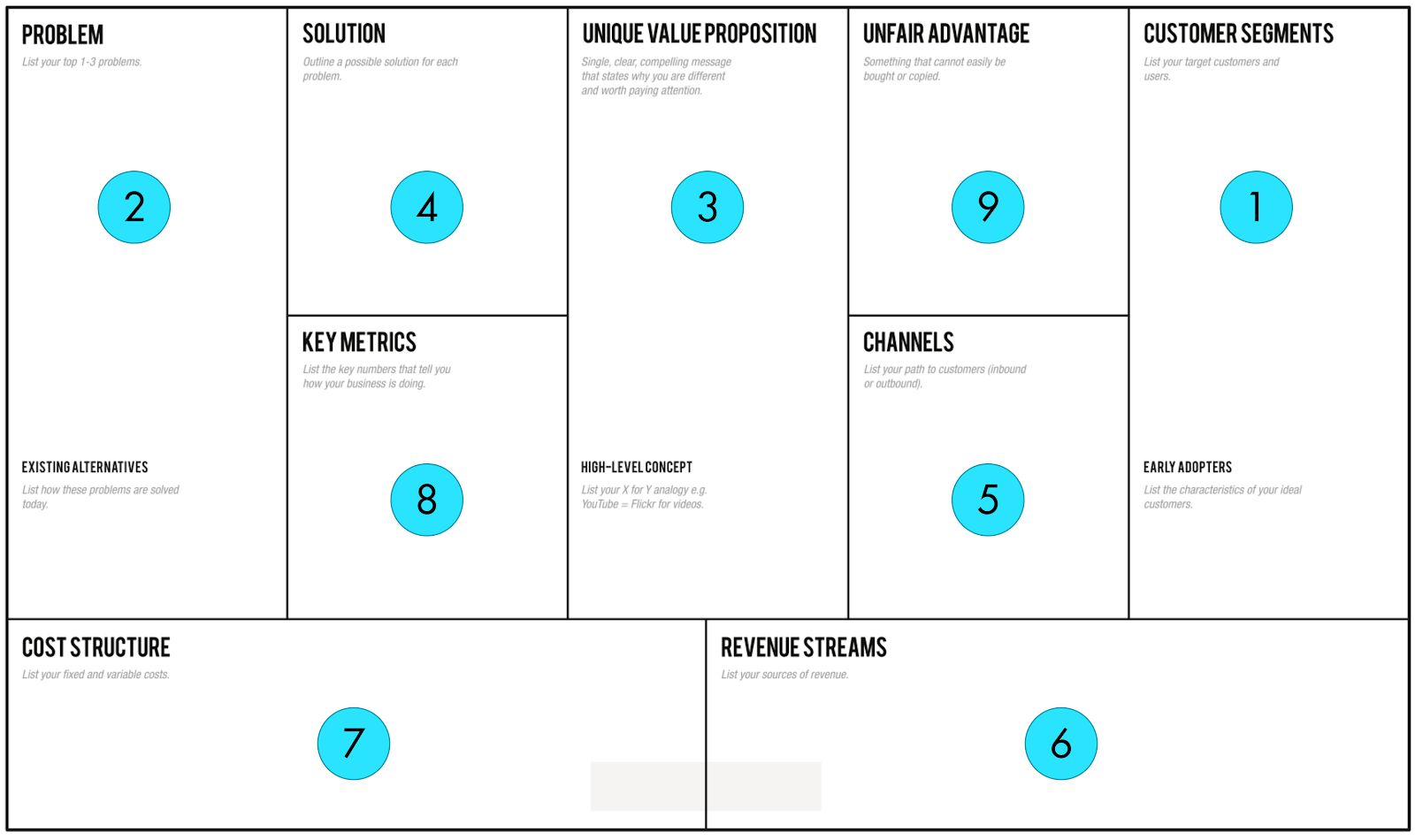What is Lean Canvas
Lean Canvas is a strategic management tool that helps entrepreneurs deconstruct their ideas into key business elements on a single page. Unlike traditional business plans, which can be lengthy and time-consuming to create, Lean Canvas provides a streamlined approach focused on action and adaptability.
Originally developed by Ash Maurya in 2010, Lean Canvas draws inspiration from the Business Model Canvas by Alexander Osterwalder and integrates principles from the Lean Startup methodology. The Lean Startup approach, coined by Eric Ries, emphasizes building a MVP to test market hypotheses and adapt products or services based on customer feedback.
Origin and Development
Lean Canvas emerged in an era when startup failures were common, and there was a growing realization that the traditional approach to business planning was not serving the fast-paced nature of startups.
Ash Maurya, an experienced entrepreneur, observed that traditional business plans were often too rigid and detailed. These documents would end up collecting dust as they did not cater to the evolving needs of startups. He found inspiration in the Business Model Canvas, which was a more visual and modular approach to business planning, but still thought that it wasn’t optimized for startups.
The Lean Startup methodology by Eric Ries then paved the way for a shift in mindset. It advocated for shorter development cycles, constant feedback, and iterative product releases. These principles resonated with Maurya, who saw the potential for a business planning tool that would cater specifically to the agility required in startups.
Thus, Lean Canvas was born – an adaptation of the Business Model Canvas but optimized for the Lean Startup approach. The Lean Canvas was more focused on problem-solving, measuring, and learning, making it more actionable and relevant for startups.
Purpose and Application
The primary purpose of Lean Canvas is to provide entrepreneurs with a clear, concise, and actionable way to develop and communicate their business ideas. Its one-page format facilitates quick iterations, which are essential for startups that need to adapt rapidly to market feedback.
Some of the applications of Lean Canvas include:
-
Idea Validation
Entrepreneurs can use Lean Canvas to quickly sketch out their business ideas and assess their viability before investing significant time and resources. -
Communication Tool
The one-page format of Lean Canvas makes it an excellent communication tool. Entrepreneurs can share it with stakeholders, including investors, partners, and team members, to convey their business ideas effectively. -
Strategic Planning
Lean Canvas helps in strategic planning by identifying the key components that need attention and resources. -
Focus and Clarity
By forcing entrepreneurs to distill their ideas into key elements, Lean Canvas helps maintain focus and clarity throughout the development process.
Anatomy of Lean Canvas
I will dissect the nine fundamental components that form the Lean Canvas.
Problem
Before you can develop a solution, you must first understand the problem you are addressing. In this section, list the top problems your target customers face. This exercise will help you focus your product or service on solving real issues that have market demand.
Questions to consider:
What problems are you solving for your customers?
How are these problems being addressed currently?
Solution
Now that you’ve identified the problem, it’s time to outline how your product or service addresses these issues. Keep in mind that, at this stage, your solution is a hypothesis that needs to be tested and validated.
Questions to consider:
- How does your product or service solve the customer’s problems?
- What are the key features of your solution?
Key Metrics
Key Metrics are the indicators that tell you if your business is progressing in the right direction. These are quantifiable measures used to evaluate the success of your business in terms of various functions and goals.
Questions to consider:
- What numbers will indicate that your business is successful?
- What metrics will you track on a daily or weekly basis?
Unique Value Proposition
Your Unique Value Proposition (UVP) is a clear statement that describes the unique benefit your product or service offers, how it solves your customer’s needs, and what distinguishes it from the competition.
Questions to consider:
- What makes your product or service unique?
- Why should customers choose you over competitors?
Unfair Advantage
An Unfair Advantage is something that your competition cannot easily replicate or imitate. It’s what gives your business a competitive edge in the market.
Questions to consider:
- Do you have insider information, a unique skill, or proprietary technology?
- What can you sustainably do better than anyone else in the market?
Customer Segments
Customer Segments are the groups of people or organizations your business serves. Understanding your customer segments is essential for creating a product or service that satisfies their specific needs.
Questions to consider:
- Who are your target customers?
- Are there niche markets you can focus on?
Channels
Channels are the avenues through which your product or service is delivered to customers. This includes both how customers learn about your product and how they purchase it.
Questions to consider:
- How will you reach your target customers?
- What are the most effective channels for distribution and marketing?
Cost Structure
This section deals with the costs and expenses associated with operating your business. It’s crucial to understand your cost structure for pricing your product and managing your finances effectively.
Questions to consider:
- What are the fixed and variable costs associated with your business?
- How can costs be minimized without sacrificing value?
Revenue Streams
Finally, Revenue Streams represent the ways your business makes money. This includes sales, subscriptions, advertising revenue, and other sources of income.
Questions to consider:
- How will your business generate revenue?
- What pricing model will you adopt?
References

